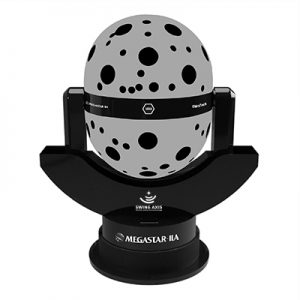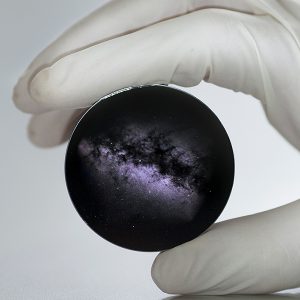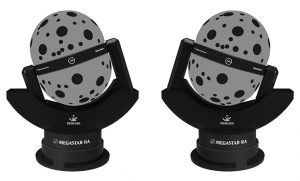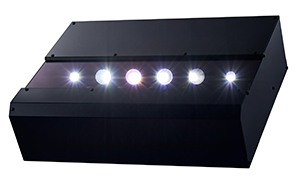

PRESS 2022.11.02
The most in the world! Equipped with the ultra-precise star plate “GIGAMASK “, which projects approximately 1.2 billion stars
Gimbal lock-free! Equipped with the world’s first cradle type 4-axis control technology “SWING AXIS”
Delivering the new MEGASTAR-IIA to the Hamagin Space Science Center
Re-opening on 1 December
 Ohira Tech has developed a new optical planetarium projector “MEGASTAR-IIA” equipped with the ultra-precise star plate “GIGAMASK“, which projects the world’s largest number of fixed stars (about 1.2 billion), and the world’s first cradle type 4-axis control technology “SWING AXIS / Ohira Tech – Gimbal Lock Free Technology”, which avoids unnatural movements caused by gimbal lock, a problem that conventional optical planetariums have been plagued by, and will deliver to the Hamagin Space Science Center. The hybrid system with the digital planetarium “Stella Dome Pro” from AstroArts will realise a variety of starry sky expressions through a smooth fusion of the sharp and realistic starry sky from optical systems and the images from digital planetarium.
Ohira Tech has developed a new optical planetarium projector “MEGASTAR-IIA” equipped with the ultra-precise star plate “GIGAMASK“, which projects the world’s largest number of fixed stars (about 1.2 billion), and the world’s first cradle type 4-axis control technology “SWING AXIS / Ohira Tech – Gimbal Lock Free Technology”, which avoids unnatural movements caused by gimbal lock, a problem that conventional optical planetariums have been plagued by, and will deliver to the Hamagin Space Science Center. The hybrid system with the digital planetarium “Stella Dome Pro” from AstroArts will realise a variety of starry sky expressions through a smooth fusion of the sharp and realistic starry sky from optical systems and the images from digital planetarium.
The reopening of the HAMAGIN Children’s Space Science Museum is scheduled for 1 December 2022. Prior to that, a preview will be held on30 November.
●The world’s largest number of stars! Equipped with the “GIGAMASK”, an ultra-precise star plate projecting approximately 1.2 billion fixed stars
 GIGAMASK is an ultra-precise star plate jointly developed by Ohira Tech and Sony Music Solutions Inc. (hereafter SMS)*¹ in 2015 and capable of projecting over one billion stars.
GIGAMASK is an ultra-precise star plate jointly developed by Ohira Tech and Sony Music Solutions Inc. (hereafter SMS)*¹ in 2015 and capable of projecting over one billion stars.
It will be the first GIGAMASK to be installed in Japan. This GIGAMASK has been made using the latest Gaia DR3 star data from the European Space Agency’s Gaia space telescope, thus it projects the largest number of stars in the world, approximately 1.2 billion from 1st to 20th magnitude.
GIGAMASK was developed by combining Ohira Tech’s planetarium technology and  star data processing technology with SMS’s ultra-precision patterning technology, which uses high-capacity, high-density optical disc mastering technology. SMS has succeeded in processing the world’s smallest ultra-fine holes of 180 nm (180 nanometres = 18/100,000 mm) in diameter, using the high-capacity, high-density optical disc mastering technology typified by Blu-ray discs. This has made it possible to accurately reproduce approximately 1.2 billion faint stars.
star data processing technology with SMS’s ultra-precision patterning technology, which uses high-capacity, high-density optical disc mastering technology. SMS has succeeded in processing the world’s smallest ultra-fine holes of 180 nm (180 nanometres = 18/100,000 mm) in diameter, using the high-capacity, high-density optical disc mastering technology typified by Blu-ray discs. This has made it possible to accurately reproduce approximately 1.2 billion faint stars.
The optical specifications remain compatible with previous MEGASTAR, and it is possible to upgrade to GIGAMASK for those where has MEGASTAR-IIA or better models.
*¹ Sony DADC Japan Inc. at the time of development in 2015.
*² For more information, see. https://www.megastar.jp/news/2015/10/13/2512/
● Gimbal lock free! Equipped with the world’s first cradle type 4-axis control technology “SWING AXIS / Ohira Tech – Gimbal Lock Free Technology” (patent pending)
 Conventional 3-axis optical planetariums can suffer from a phenomenon known as gimbal lock, whereby certain operations result in unnatural movements, preventing the stars from moving smoothly. To avoid this, Ohira Tech has developed the world’s first new technology that allows the star to move smoothly by adding a cradle-type fourth axis to the bottom of the starball.
Conventional 3-axis optical planetariums can suffer from a phenomenon known as gimbal lock, whereby certain operations result in unnatural movements, preventing the stars from moving smoothly. To avoid this, Ohira Tech has developed the world’s first new technology that allows the star to move smoothly by adding a cradle-type fourth axis to the bottom of the starball.
 As a result, it is possible to avoid unnatural movements that occur when passing through a singularity, and the optical stars smoothly follow the background image projected from the digital planetarium at high speed, even in scenes where we jump out of the ground into space.
As a result, it is possible to avoid unnatural movements that occur when passing through a singularity, and the optical stars smoothly follow the background image projected from the digital planetarium at high speed, even in scenes where we jump out of the ground into space.
With a hybrid projection system with optical and digital systems, it has been necessary to switch from optical stars to digital stars when flying into outer space, but with a MEGASTAR equipped with SWING AXIS, sharper and more realistic optical stars can be used in even more scenes.
● New XY-type dome-edge planetary projectors
 In addition to optical sun and moon projectors, we newly developed XY-type planet projectors installed on the edge of the dome will be installed for the first time in Japan. Until now, optical planetary projectors have been installed in the centre of the dome, but with the originally developed dome-edge type, you can use the dome space more effectively without putting pressure on the seating space.
In addition to optical sun and moon projectors, we newly developed XY-type planet projectors installed on the edge of the dome will be installed for the first time in Japan. Until now, optical planetary projectors have been installed in the centre of the dome, but with the originally developed dome-edge type, you can use the dome space more effectively without putting pressure on the seating space.